A few years ago, we covered some prime examples of nudge marketing.
As you can tell from that post, we love a good nudge campaign – it’s a subtle, simple way to get a lot of bang for your marketing buck.
So we’re back with some more examples of how the humble nudge can be used well. We’re covering a few new nudge strategies, as well as revisiting some old favourites from our earlier post.
But before we dive in, here’s a brief refresher on the humble nudge.
What’s Nudge Marketing?
Instead of hitting your customers over the head with your call to action, nudge marketing is meant to gently push your customers towards the action you want using subtle cues.
It is essentially a consumer influencing strategy: by manipulating how and when information is presented to consumers, you can steer them towards the behavior you’re hoping for. By subtly promoting the choice you want people to make, they’ll gravitate towards it without even noticing.
There’s a pretty strong theoretical basis for this.
Nudge theory has been prevalent in politics and behavioral economics for decades, and it was popularized in a 2008 book by economists Richard Thaler and Cass Sunstein. In the book, they describe a nudge as ‘any aspect of the choice architecture that alters people’s behavior in a predictable way without forbidding any options or significantly changing their economic incentives.’
So what does this look like in practice?
There are countless examples of nudges out there: the UK government has had its own dedicated ‘Nudge Unit’ dedicated to encouraging people to make better social choices; supermarkets use nudge marketing to boost produce sales; and nudges have been used in some industries to achieve a ‘zero accident’ workplace culture.
So how can you use the power of the nudge to your advantage? Here are five examples of easy-to-implement nudge strategies.
1. The Cognitive Ease Nudge
This one is pretty intuitive: people are less likely to do something – whether it’s buying a product or signing up for your service – if they think it’s going to be hard.
On the flip side, a perception of ease can be a powerful nudge towards engagement or purchasing.
Take the map feature on Zipcar’s website for example. They’ve identified a major barrier to car share use (the perception that shared cars are scarce and hard to find), and they’ve used the map to subtly tell users how easy a Zipcar is to find and use.
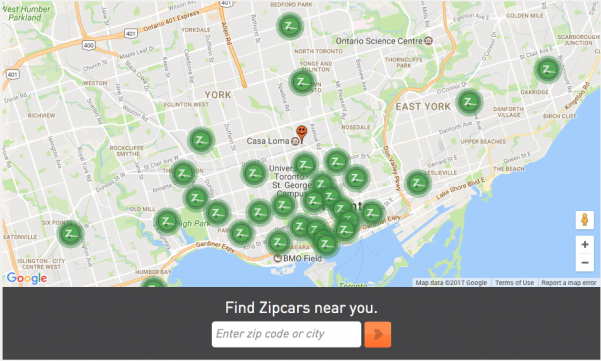
The brilliance here is that they’ve figured out what their potential customers perceive as the hard part of using their service, and they’ve sent out subtle cues that they’ve got those concerns covered, eliminating a major barrier stopping customers from taking the plunge.
2. Embedded Nudges
This nudge works by embedding a desired action into your website’s user flow.
If a nudge towards a particular action pops up at a natural point in your user’s experience, they’re more likely to take your cue. Embedded nudges are particularly great for getting people to sign up or subscribe to your content, so you’ll see this nudge a lot on blogs or news sites.
In the past, marketers tended to use obvious, disruptive embedded nudges like modal windows. But recently, there’s been a shift toward subtler embedded nudges.
The Harvard Business Review’s website does this especially well. At the bottom of every article, they tell you how many free articles you have left to read, and then prompt you to register to access more. If you’re reading (and enjoying) an article and you see a subtle prompt to subscribe at the bottom of the page, the chances are good that you’ll at least be tempted to take them up on that cue.
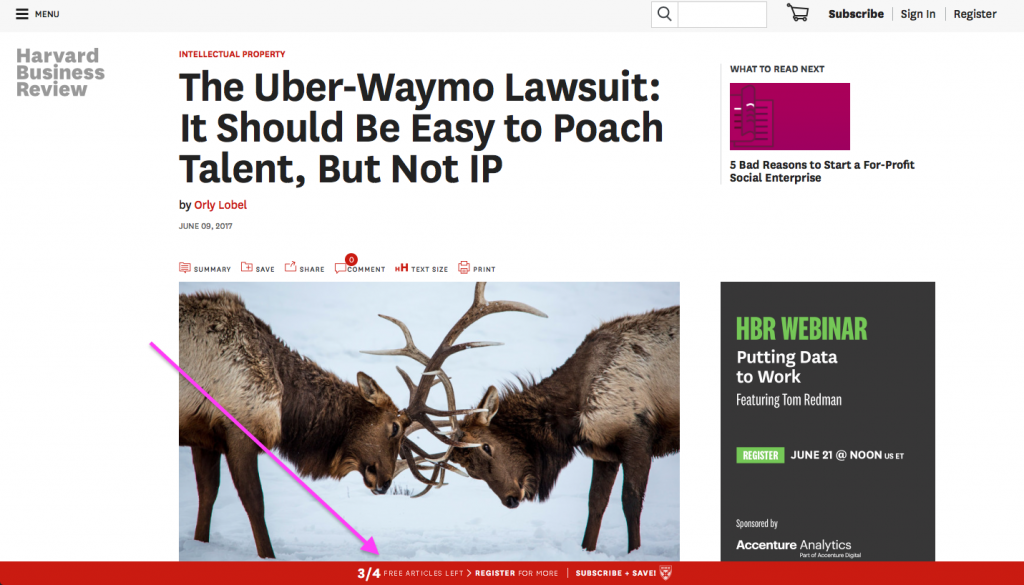
3. The Scarcity and Loss Aversion Nudge
This nudge sparks users’ FOMO. Advertisers have leveraged the fear of missing out for decades, and that’s because creating a perception of scarcity works as a powerful trigger for customers.
Humans are naturally loss averse – it turns out that people’s desire to avoid loss is even greater than their desire to acquire gains.
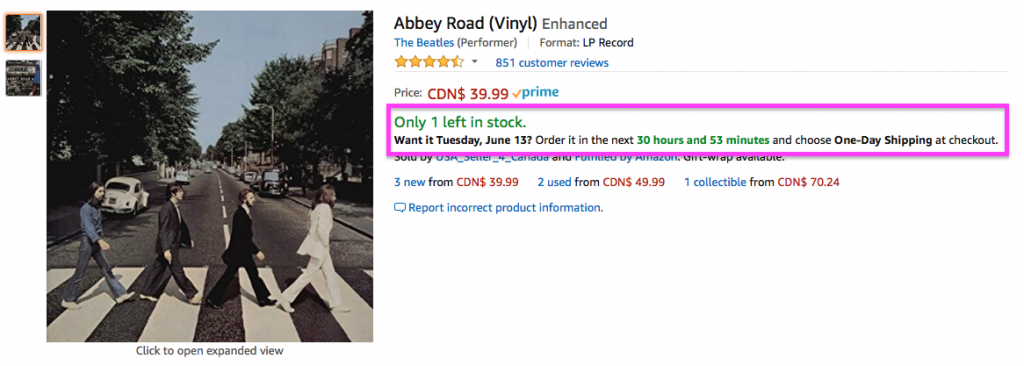
via Amazon
Scarcity comes in a few different forms: you can make your content seem exclusive, you can make an offer time-limited, or you can show potential customers that supplies of your product or service are running out. All of these things nudge people towards taking action quickly.
4. The Social Proof Nudge
We covered the social proof nudge in our previous blog post, but we’re revisiting it here because it’s a tried and true nudge method.
The basic premise of this nudge is that people are pack animals, and we love to follow the crowd.
There are a few approaches you can take to the social proof nudge. You can tell your site visitors what people have liked in the past, or you can show off your social network connections and media likes and follows. You could feature ‘as seen in’ media logos on your site, or throw some influencer endorsements up on your web page.
As with the embedded nudge, however, social proof nudges have been getting more understated (but no less effective) over the past few years.
AirBnb’s booking system is a good example of the social proof nudge in action. When you’re browsing, they tell you how many other people are searching their site for the same dates as you.

And once you land on a home to rent, the site tells you how many other travelers have ‘saved’ the place you’re looking at, and shows you other travelers’ reviews.
AirBnb’s use of the social nudge gets bonus points for activating the scarcity nudge at the same time.
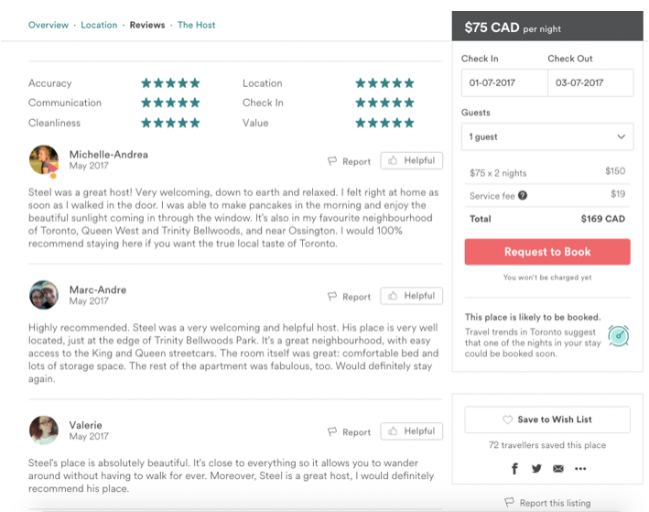
5. Authority
People trust the experts, and subtle references to authority and expertise can provide a good nudge.
You can do this through expert testimonials and quotes, but our favorite authority nudges are well-chosen, well-placed statistics.
People tend to perceive stats – especially those that indicate success or know-how – as symbols of authority.
This nudge is a bit more of a long-game – it’s not going to directly steer people into taking a particular action, but that’s OK. It’ll still nudge people towards trusting and engaging with your product, which is a pretty good outcome if you ask us.
Here’s a good example from Hubspot’s site:
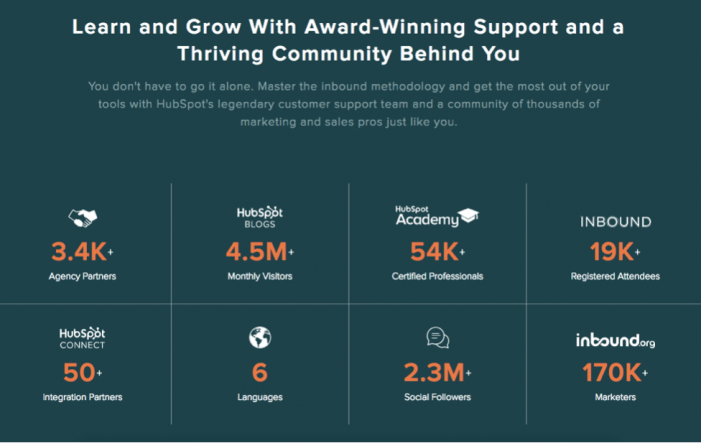
Wrap Up
Nudges are deceptively simple – they’re not flashy, and they don’t have a lot of bells and whistles. But done well, an unassuming nudge can set off your users’ complex psychological triggers in powerful ways.
